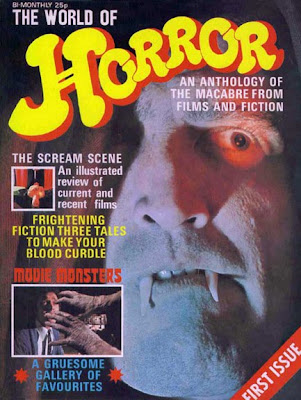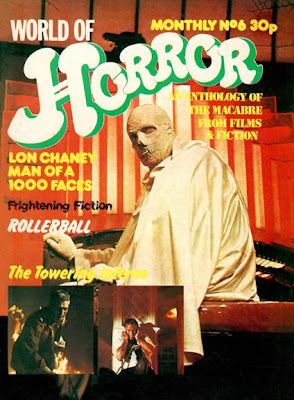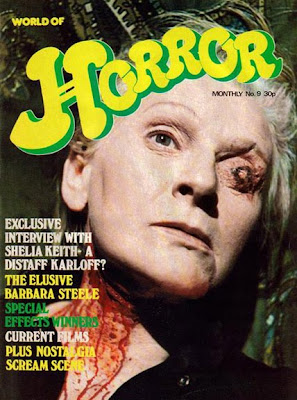
Life before Fangoria, without even Famous Monsters of Filmland...
This is a follow-up to my first horror movie books. A snapshot of some of the first books on the subject in the mid-1970s, when interest in the genre was only just being recognised and exploited.
As a schoolboy, I had to ask for those books as birthday or Christmas presents. More affordable, but just as rare, were horror movie magazines. At the time, I ran (well, cycled) around local newsagents looking for Marvel, DC and Charlton comics. They often only had a couple of copies of each edition, making collecting a set almost impossible. Many of my titles only started at 2 or 3 rather than number 1. Ten years old and already collecting...
At first, these American comics would have a large English price stamped in ink on the cover art - ruined! They were later reprinted for the UK with an English price on the front (these are now less valuable than the originals). I followed a few superheroes, my favourites were Batman and Jack Kirby's futuristic New Gods and Mister Miracle. I also enjoyed the spooky comics like House of Mystery, Creepy, Eerie, Tales of the Zombie, Where Monsters Dwell... I remember having some independent (non-code) horror comics confiscated off me in school when I was ten! Hang on, I feel a new post coming on...

I was also reading horror and sci-fi paperbacks. While digging around for secondhand copies and old comics, I started getting movie tie-in 'novels', the covers of which you may have spotted already in these pages.
But I really wanted to find out more about monster movies and horror films. I'd daydream about what they were like based on the promise of the photos. Books on special effects were fascinating, but of course weren't up to date.
I've heard that other Brits had better luck finding them, but for me there was an almost complete absence of copies of Famous Monsters of Filmland. My childhood perception of the genre developed very differently than kids in the US, where that magazine defined the appetites of generations of horror, sci-fi and monster fans. Without it, and years before Fangoria started being published and internationally distributed, this is what I found instead...

Searching through American comics it was a fluke that I found For Monsters Only (1972) - my first American horror movie mag. Scream and Scream Again was on the cover, with a long article summarising the plot with a dozen large graphic and atmospheric photos. This built up my expectations for eventually seeing the film on TV. The insanity depicted on the cover made me almost dread seeing the film.
Most of its other monster movie photos were only included with jokey balloon dialogue added, but they whet my appetite for the creatures from The Alligator People, I Married a Monster from Outer Space and many more. This was the only edition I found.

A more serious magazine but with less threatening cover art, Movie Monsters only ran for four issues over 1974/75, but had long valuable retrospective photo articles on many genres and horror stars. This and For Monsters Only were printed on pulpy black and white paper, apart from the cover. They were both obvious rivals to Famous Monsters of Filmland, focusing on traditional monster movies and classic horror. My next find was something different...

British magazine The World of Horror made more of an impact because of the large amount of glossy colour photos inside. I caught it from issue 1 - a mixture of photos and articles, some cartoons and a short story. It started off covering Amicus and Tyburn films and the last gasp of Hammer horror, fleshed out with sci-fi movies like Zardoz, and TV shows. The photo spreads were wonderful, issue 5 had three pages for Tales from the Crypt that made me even more desperate to see it.
In retrospect, there were valuable mentions of stage show revivals of Dracula, and Phantom of the Opera (which I saw) and even Jack the Ripper (the musical!), plus a colour spread on The Rocky Horror Show as it hit the stage for the first time on the King's Road in Chelsea.

But with issue 6, the magazine was the perfect place to feature new horror hits like The Exorcist and Young Frankenstein, then Flesh for Frankenstein, Phantom of the Paradise, and a great centre-spread for Flesh Gordon, plus my first glimpse of Living Dead at the Manchester Morgue. Issue 7 looked at the animatronic effects work of Roger Dicken with behind the scenes shots of Land That Time Forgot, The Creeping Flesh, Scars of Dracula and Blood Beast Terror - this was a few years before his astonishing work on Alien (for the Chestburster and Facehugger).
The World of Horror ran a balancing act. Its Doctor Who and Star Trek covers would appeal to younger viewers, but was supposedly aimed at an older audience, with many photos of partial nudity and memorably gory colour shots from Frankenstein - The True Story,(bloody arm in a bag), Tyburn's The Ghoul (sacrificial dagger in the head), Sisters (really messy blood drinking) and Tommy (Robert Powell's burnt face).

But then it downgraded to more pulpy paper in issue 8, and despite an interview with Sheila Keith and a spectacular cover from Frightmare for issue 9, that was the last of the wonderful World of Horror.

The even gorier Monster Mag lasted a little longer. A full-colour, foldout poster magazine - poster on one side, vivid and graphic gory photos on the other. This controversial publication was showing blood-spattered corpses and decapitations five years before Fangoria got started. Issue 2 was famously banned, confiscated and destroyed by Her Majesty's Customs and Excise (en route to England from the printers in Italy) and not a single issue seems to have survived!

I discovered it in 1974 at issue 6 (I was twelve or thirteen), but could only buy it if the newsagent wasn't paying attention. In small writing on the cover, it said 'For Sale To Adults Only', which I'd try and hide with my thumb across the corner (ahem). This didn't always work, leaving a few holes in my collection. The infuriating lack of captions also meant that I didn't know all the films the photos were from. It was years before I worked out that the foldout poster of the skeleton on a wheel was from Ken Russell's The Devils.
Hammer, Amicus and Tyburn provided the juiciest photos and poster material, including a repro of the Horror of Dracula poster in one of the last issues. They seemed to have problems getting photos from American films like The Exorcist, using silly artwork instead. But the poster in issue 14, one of Christopher Lee's many Dracula death scenes, struck me as horrifying. Just a little blood, rotting skin, bloodshot eyes, and smoke pouring through his hair, but he looked like he was dying and disintegrating in a truly violent horrible way. Of course, it went straight up on my bedroom wall.

The text was almost irrelevant, mainly plot descriptions. But those photos! Issue 6 had a torn-out throat from The Beast Must Die that was almost medical. Issue 8 had an extraordinary look at the gory stage shenanigans of the Grand Guignol theatre of Paris. Eating 'intestines' on stage! Issue 2 of volume 2 had a wonderful spread of bloody photos from Vampire Circus. Then, for its last issue, Monster Mag ran a full page ad for a new magazine, The House of Hammer...

A mention here for Legend Horror Classics, another foldout poster format running at the same time, but mostly filled with a black and white horror cartoon strip. The cartoony covers put me off most issues. But the Death Line cover (1974)! Bloody hell! I got that one for the cover alone! When TV eventually showed a dark, shadowy print of Death Line, it couldn't possibly live up to the impact of this photo.

I finally lucked into a couple of copies of Famous Monsters of Filmland, my first being 117 in 1975 (at an indoor market in Sheffield). For years, I only had three issues! Of course I wanted more, but couldn't find any. 117 and 118 had a photo story of 20 Million miles to Earth which I took to a schooltrip to Rome to specifically compare the climax of the film with the actual Colosseum. I'd not even seen the film yet...

I also found two issues of Monsters of the Movies at the same stall. Issue 7 devoted most of its space to telling the story of Horror of Dracula in text and dozens of photos, some of which weren't even in the final print (like Harker's vampiric corpse)! Again, this was years before I got to see the film on TV, after I'd seen two of the sequels! The article used many frame blow-ups to be able to illustrate the whole story.

Then the British magazine, The House of Hammer started up in 1976, hyping Hammer films but also reporting on the latest horror and sci-fi films. This was rewarding for providing regular, up to date news and reviews of current releases. Through issue 6, I even got to see a preview screening of Squirm despite being underage.
This was also where I first saw extensive coverage of emerging classics like The Texas Chainsaw Massacre, although most cinemas weren't allowed to show it in the UK. Other reviews included The Crazies, The Omen, Suspiria, oh yes and Star Wars. Sci-fi was about to obliterate horror magazines in the UK for a few years...

Hammer fans chase this mag because of the dynamic comic adaptions of some of the classic films, notably with better artwork than some of the covers. Importantly, it also imagined (unfilmed) sequel stories for the vampire hunters Father Shandor and Captain Kronos.

The contents were on black and white pulpy paper, but there was usually a glorious poster reproduction on the back cover. It found time for horror films from other continents and great retrospectives of early classics by Denis Gifford, author of A Pictorial History of Horror Movies.

At 15, I started heading into central London, to find the stores advertised in the above magazines. There they stocked more specialist magazines and imported some from America, though they were quite expensive. My first treasure was Photon, a glossy fanzine that looked extensively behind the scenes and interviewed filmmakers and genre stars, spending just as much time on older films as new. An interview with Kenneth Tobey and the making of The Thing From Another World, David Allen talking about animation in fantasy films, an in-depth look at the two versions of Curse of the Demon, Brian De Palma talking about Phantom of the Paradise - all solid information, long articles and no adverts. The glossy black and white format was perfect for great reproduction of rare photos.
My first were a back issue of 22, and a new copy of 26 - each one had a free 10 x 8 print included of one of the featured films. I got them from The Cinema Bookshop in Great Russell Street - but despite being devoted to films, this had a very small section on horror, focusing instead on classic movie stars and auteur directors.


Here I found Cinefantastique, like Photon it was a fanzine turned pro, applying professional criticism and analysis to a similar mix of classic sci-fi and horror. But with regular issues and plenty of colour, it endured to document genre film and TV until 2007. In 1976, I only bought the issues about films I wanted to learn more about - my first being Logan's Run and Carrie. I couldn't afford to get every issue (until much later), but the Star Wars and Close Encounters double issues were must-haves, giving unprecedented coverage about their production, not even covered in such detail in the promotional tie-in magazines and books.

The sci-fi boom had started, a dozen new space-oriented movie mags appeared (like Starburst, Starlog and Sci-Fi Now) and certainly distracted me for a while. But with effects-heavy slasher movies on the rise, the splattery coverage of Dawn of the Dead and Phantasm were about to launch Fangoria into international success. I never had trouble finding copies in the newsagents! So in 1979, my hunt for a regular supply of horror magazines was over...
Hungry for more classic horror mags? Here's a wonderful blog all about these and other Monster Magazines, featuring more of these terrific front covers.


















 But there's isn't a dull moment with all the bad science, bad drama, man-eating plants (well, woman-eating plants) and many of your favourite plot points from many other Cohen productions. Heavily influenced by the strong-
But there's isn't a dull moment with all the bad science, bad drama, man-eating plants (well, woman-eating plants) and many of your favourite plot points from many other Cohen productions. Heavily influenced by the strong- Some of the
Some of the 










